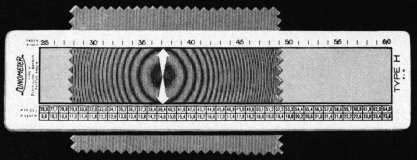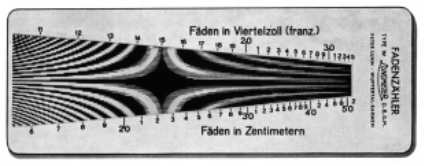
1. The moiré principle
As long ago as 1874, Lord Rayleigh, who subsequently won the Nobel Prize for physics (1904) recorded graticular figures which occurred when superimposing very fine grids on top of each other. This optical phenomenon was later designated by the term moiré because of its watermarked effect. Nowadays, the term is used in essentially three modes: In television technology to describe picture distortion in the form of a line pattern on the screen of a receiver; in the printing trade to describe the undesirable patterning brought about by faulty embossing and above all, in the textile industry for the quite unique and very changeable fabric patterning.
In the present article, we shall be concerned entirely with the original definition of the moiré principle: In the same way as two different superimposed grids can lead to a moiré pattern, the same phenomenon can be created by placing a grating on a textile cloth. The resultant moiré effect finds practical application in the technical measurement of the textile fabric in question.
2. Technical application of the principle in the moiré grating
The procedure is relatively simple: If the metric properties of the superimposed grating are known, then, in the event of a moiré pattern being formed, one can draw conclusions on the metric quality of the textile fabric beneath the grating. lt is on this principle that the mode of operation of the lunometer is based; the lunometer is a commercial instrument made of artificial glass with etched in grating lines. By placing this instrument on a textile surface, the lines of the instrument are coordinated with the structure of the fabric. Superpositioning ("interference") of the two grid systems will be observed. Since the grating of the instrument is one with linearly increasing grid constant, there must be somewhere in this "interference field", a zone where there is complete harmony of both gratings: This is the centre piont of the clearly forming "interference pattern".

The scale beam provided on the side of the instrument, indicates the density value of the grating at this point and therefore the required density value of the sample as a whole.
The reading of this value is facilitated by the distinctly increasirg width of the moiré lines in the direction of the interference centre.
3. The textile practical functions of the lunometer
In its practical application, there are three particular functions in which such grid bars have proved useful:
3.1 Measuring the thread density (Set or thread count)
The lunometer is used mainly to determine the thread density (set or thread count) on any cloth or knitted fabric having a parallel structure, e. g. a linen weave. For this purpose, the instrument is laid as parallel as possible to the thread direction to be examined and on top of the sample. An interference pattern will appear immediately, taking the shape of an oval, complete pattern (in the case of parallel grid systems; in a hyperbolic form in the case of radial grid systems). The middle axis of the interference picture is important for an accurate reading of the thread count (number of picks) based on the instrument scales.

The number of laterally running threads (warp threads) can also be ascertained in this manner: By slowly rotating the instrument, the moiré pattern changes and disappears almost completely at an angle of 45°. On further rotation up to 90° the moiré pattern will again emerge quite distinctly and will now relate to the laterally running threads. Measurements can be carried out in daylight without any artificial lighting. In the case of dark and black woven or knitted fabrics, a more contrasting interference pattern will be obtained with transillumination in preference to incident light. Besides this significance in the field of measurement technology, the instrument is capable of performing additional functions which are not always discussed in the comprehensive handbooks, which concentrate on the lunometer simply used as a thread "counter" or as a "thread density meter".
3.2 Localisation of fabric faults
Of almost equal importance is the facility for determining possible defects in a cloth. Faults in the fabric to be examined, for example, variations in the pick count by only a few per cent, are clearly discernible by the broken pattern of the interference lines; similarly, differences in thread denier, thread lays, colour faults, etc. can be noted. In each case, the moiré figure will appear asymmetric. For all these irregularities in the fabric being tested, there is quite a specific phenomenon in the interference pattern of the instrument.
3.3 Testing for shrink-resistance
Finally, a particular advantageous application of the lunometer, both in the test laboratory as weIl as in the textile processing, has been the measurement of dimensional changes (shrinkage, contraction) of textile fabrics. lt is known that such dimensional changes take place frequently during the wet treatment in textile finishing (during dyeing, crease-resistance treatments, washing and the like). Many textiles, particularly those based on cellulose hydrate fibres or on wool, have the property of shrinking during such wet treatments. This shrinkage of the textiles is attributable in part, to the swelling potential of some fibres in water. For example, textiles made from regenerated cellulose fibres, such as rayon or rayon staple display a pronounced swelling phenomenon when immersed in aqueous liquors. In this case, shrinkage proves to be a purely mechanical process. The cross section of the fibre increases and the length contracts.This condition remains after drying, with the result that there is a contraction in the fabric length.

The lunometer has also proved useful in the examination of such and similar dimensional changes. Generally speaking, textiles are tested for shrinkage resistance in the following manner.
A square of 50 cm x 50 cm is marked with indelible ink on the section of fabric to be examined. Along each edge, three marks are made at intervals of 2, 25 and 48 cm, the distances being measured accurate to one mm between the vertically lying marks. The textile sample is placed in a wash liquor, comprising per litre of water, 5 g soap and 3 g soda to give a liquor ratio of 30 :1 and at a temperature of 40° C. The liquor is brought to the boil over a period of 20 minutes and held at the boil for a further 10 minutes.The sample is left to cool in the liquor for 10 minutes, after which it is rinsed several times until the rinsing water is clear.The sample is then centrifuged and laid out to dry. (Wringing or hanging-up the sample should be avoided so as to obviate any distortion or elongation in one direction). After drying, the sample is lightly shrunk under a pressing iron (without moving the iron) and pressed flat. Finally, the fabric is left to cool for 10 minutes and the marked dimensions are cheeked. The mean value is taken from the three measurements in each fabric direction and the contraction of the cloth is calculated as a percentage, referred to the dimensions before washing.
The above described procedure can be simplified by using the lunometer. The same washing specification is used, but one dispenses with the marking of the square on the sample. lnstead, the lunometer is used to ascertain the number of threads or stitches at various positions of the sample, before and after the washing, and from these measurements, one calculates the dimensional change (shrinkage or elongation) as a percentage. This sirnplified procedure is moreover of advantage when dealing with examination of finished articles of clothing, on which it is no longer possible to mark out squares or to cut out samples.
4. Time-saving advantages of the lunometer
An important factor in the overall assessment of moiré gratings lies in the time-saving advantage in its application. Determining the number of threads or stitches by means of the lunometer takes place more quickly than counting out the threads with the aid of a magnifying glass. For example, to ascertain the thread count of 20 fabrics with a pick count of about 40 ends per cm, by counting with a magnifying glass takes about 15 minutes, but at most 6 minutes when measuring with a lunometer. This evidence was provided following a test carried out at the National Institute for Textile Chemistry (Badenweiler).
Moreover, even with the above described testing of shrinkage resistance, using the lunometer, the time saving factor is considerable: The time required for marking out the square can be saved; similarly, one dispenses with the graduations to one mm accuracy and their subsequent checking. With the lunometer, the instrument is simply placed on the cloth at various positions and the pick counts are read off, before and after the washing treatment.
Furthermore, there is considerably more strain on the eyes when counting with the aid of a magnifying glass, compared with the automatic assessment with the lunometer, especially when dealing with woven or knitted fabrics of very dose construction. There is the additional factor that counting with the magnifying glass involves subjective techniques, with the possibility of error in establishing the actual number of threads.

5. The industrial scope of application for the lunometer
The lunometer obviously finds its widest scope for application in the textile industry. The above mentioned funcctions of the instrument apply to all types of cloths (in the weaving room on the loom, in fabric inspection and at mending, in the warehouse) as weIl as to knitgoods (e.g. jersey during finishing) for examining the course-like structure (poplins, etc.). Similarly, reed inspections can be undertaken with the lunometer.
Another field of application for the lunometer is in the metal industry, specifically in the wire industry: Mesh sizes of wire screens, metal cloths and test sieves have been ascertained with the aid of the lunometer for some decades.
The printing sector has also sought the use of the lunometer: The present day advanced technology of screen printing, in particular, the multi-color screen printing technique places extremely high demands on the uniformity of the natural silk, nylon, Perlon and polyester cloths used for this purpose and this sector of industry is therefore compelled to undertake some technological inspection of its screen cloths.
6. Final observations
For the various ranges of measurement, five different standard types have been developed according to the greatest demand:
Cf. the link "Produkte" !
In addition, smaller radial grating rules are available. Only the American types of lunometer differ to some extent in designation and measuring range from the above described types and are marketed under Iicence. All instruments are sold complete with neat cases in the same manner as small slide rules, and are designed to be carried unobstrusively in the pocket.